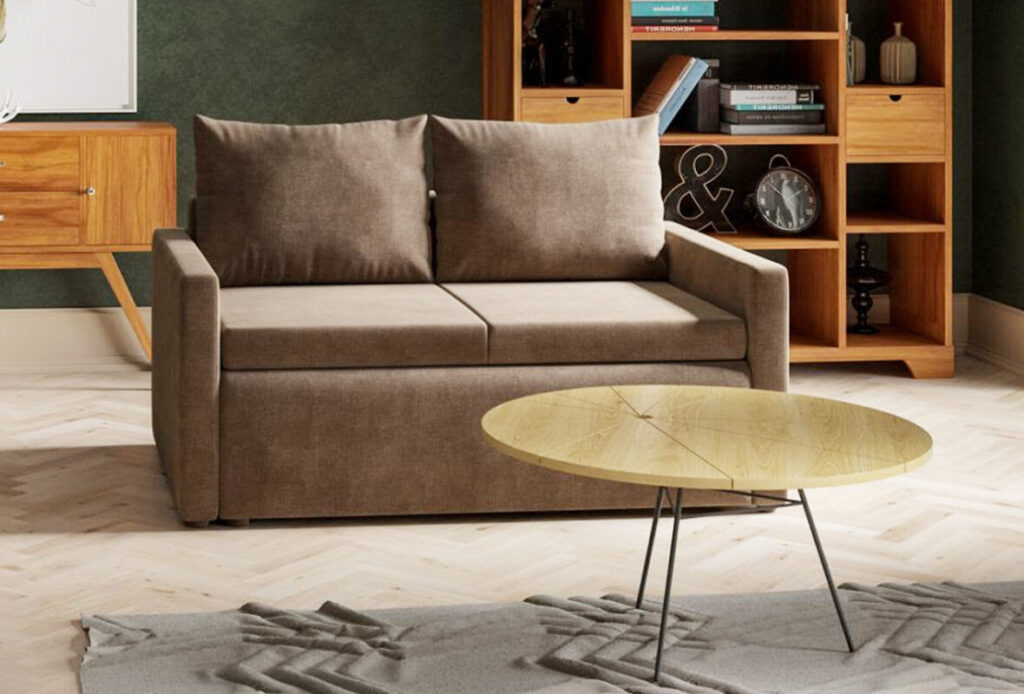Sofa – the centerpiece of the living room. Guests gather on it for conversations, family members sit on it to watch TV or play games. The sofa should not only be comfortable but also attractive to complement and harmoniously emphasize the living room interior.
Semi-circular Sofa
A variation of the corner sofa is the semi-circular model with no sharp corners. It is equally functional as its predecessor but looks more unconventional and noticeable, which can become a highlight of modern living room interiors. The semi-circular sofa can be placed in front of a home theater or fireplace, making it the focal point of the composition. To ensure that such a model looks harmonious in the living room, repeat the semi-circular line in the interior once again, and the sofa will not look out of place among sharp corners. If you don’t want to experiment, place the sofa against the wall or in a corner using the traditional method.
For a Spacious Living Room
First, determine the size of the room. If the living room area is quite large, a large-sized sofa is appropriate. Pay attention to the corner model: it smoothes out the room’s corners and is suitable for spacious areas. Corner sofas are often equipped with various additions, such as a table, stand, or even a mini-bar. It’s hard to imagine more suitable furniture for a large family living room or for those who love to entertain guests.
Another option for spacious living rooms is two small-sized sofas. They can be placed opposite each other if you adhere to the principle of symmetry when arranging furniture. This arrangement is especially common in classic-style living rooms. Or you can place them in a “G” shape, mimicking a corner sofa. It’s not necessary to place sofas flush against the wall; in the case of a spacious living room, sofas placed in the middle of the room will look more original. However, this option is suitable only for those who have plenty of free space. Don’t forget to leave 1-1.5 meters for passages.
For a Small Living Room
For a modest-sized living room, choose similarly small sofas. Proportion is important: a bulky sofa will look out of place in a small room and will take up extra space that could be used more rationally. Small sofas are not lacking in functionality: a sofa bed for the living room will come in handy during long visits from friends, and it’s convenient to have a sofa with compartments for storing bedding. Another secret for small spaces is furniture in light shades. Classic white, soft beige, pink, gray, ivory, and countless variations will suit owners of modest living rooms as sofa colors.

For a Rectangular Living Room
It is commonly believed that the ideal shape for a living room is square. However, rooms with such geometry are not always encountered. If your living room has an elongated rectangular area, a sofa placed near the smaller wall will help “level” it. Zoning is often used for such rooms; in this case, a sofa installed across the room’s center can serve as a kind of partition dividing the relaxation area and the dining or work area. You can also use the previously mentioned “G” shaped sofa along with a coffee table in the center of the soft seating group. Asymmetric furniture arrangement will be suitable for a rectangular living room.
Upholstery
The second most important aspect, after size, when choosing a sofa for the living room interior, is its upholstery and texture. Here, much will depend on personal preferences and budget. It’s no secret that natural materials are the most durable and practical, but they will cost more than their synthetic counterparts. The highest quality materials for sofa upholstery are considered to be flock, velvet, and chenille. Flock upholstery is easy to clean and suitable for households with pets, although this material may not be as comfortable for sleeping. Velvet is very soft and cozy but requires careful maintenance. Chenille is durable and comes in a rich variety of colors. Jacquard, cotton, wool, microfiber, and Teflon fabric are also used for sofa upholstery. Each material has its advantages and disadvantages, so choose a sofa for the living room interior responsibly.
Undoubtedly, a leather sofa is a favorite for any homeowner. Genuine leather is durable, not to mention its appearance: a leather sofa can make even a simple and unpretentious living room interior look luxurious. However, its price is high, and it would be very disappointing if the sofa were damaged by pets or small children. That’s why many prefer sofas made of synthetic leather substitutes, which often look no different from the original on the outside. But, of course, it’s worth choosing more expensive analogs if you don’t want the sofa to crack quickly and become unusable.

Sofa Color
The color of the sofa is the third component when choosing the right model. Everything here depends entirely on the design of the living room and the overall style. A bright sofa will boldly and non-trivially look in interiors with restrained tones. Duplicate its color in several details, and you’ll get a striking decor. Gray, brown, blue, or black sofas will complement the pastel hues of the interior well. The main thing is that the color of the sofa should not match the tone of the walls, floor, and ceiling; otherwise, the entire decor will merge into one large spot and lose its attractiveness. Don’t be afraid of a white sofa: removable covers have long been invented, making cleaning easier.
